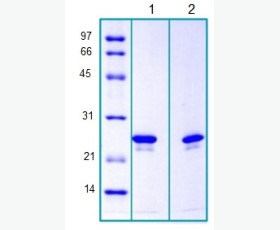Recombinant Human Creatine Kinase, Muscle/CKMM
| Product name: | Recombinant Human Creatine Kinase, Muscle/CKMM |
| Source: | Human Cells |
| Purity: | Greater than 95% as determined by reducing SDS-PAGE. |
| Buffer Formulation: | Supplied as a 0.2 μm filtered solution of 20mM TrisHCl,150mM NaCl,10%Glycerol,pH7.5. |
| Applications: | Applications:SDS-PAGE; WB; ELISA; IP. |
| Storage: | Avoid repeated freeze/thaw cycles. Store at 2-8 oC for one month. Aliquot and store at -80 oC for 12 months. |
| UOM: | 100ug/50ug/200ug/1mg/1g |
| Source | Human Cells |
| Description | Recombinant Human CKMM is produced by our Mammalian expression system and the target gene encoding Met1-Lys381 is expressed with a 6His tag at the C-terminus. |
| Names | Creatine kinase M-type,Creatine kinase M chain,M-CK,CKM,CKMM |
| Accession # | P06732 |
| Formulation | Supplied as a 0.2 μm filtered solution of 20mM TrisHCl,150mM NaCl,10%Glycerol,pH7.5. |
| Shipping |
The product is shipped on dry ice/ice packs. |
| Storage |
Store at < -20°C, stable for 6 months after receipt. Please minimize freeze-thaw cycles. |
| Purity |
Greater than 95% as determined by reducing SDS-PAGE. |
| Endotoxin | Less than 0.1 ng/µg (1 IEU/µg) as determined by LAL test. |
| Amino Acid Sequence |
MPFGNTHNKFKLNYKPEEEYPDLSKHNNHMAKVLTLELYKKLRDKETPSGFTVDDVIQTGVDNPG HPFIMTVGCVAGDEESYEVFKELFDPIISDRHGGYKPTDKHKTDLNHENLKGGDDLDPNYVLSSR VRTGRSIKGYTLPPHCSRGERRAVEKLSVEALNSLTGEFKGKYYPLKSMTEKEQQQLIDDHFLFD KPVSPLLLASGMARDWPDARGIWHNDNKSLLVWVNEEDHLRVISMEKGGNMKEVFRRFCVGLQKI EEIFKKAGHPFMWNQHLGYVLTCPSNLGTGLRGGVHVKLAHLSKHPKFEEILTRLRLQKRGTGGV DTAAVGSVFDVSNADRLGSSEVEQVQLVVDGVKLMVEMEKKLEKGQSIDDMIPAQKVDHHHHHH
|
| Background | Creatine kinase M-type is also known as Creatine kinase M chain,M-CK. It is a protein that in humans is encoded by the CKM gene. It belongs to the ATP:guanido phosphotransferase family,containing 1 phosphagen kinase C-terminal domain and 1 phosphagen kinase N-terminal domain. Creatine kinase M-type can reversibly catalyzes the transfer of phosphate between ATP and various phosphogens. It plays a central role in energy transduction in tissues with large, fluctuating energy demands, such as skeletal muscle, heart, brain and spermatozoa. |














